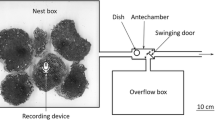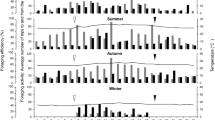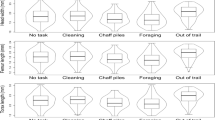Summary
-
1.
An Oscillatory Recruitment Display (O.R.D.) has been described inMonomorium andTapinoma.
-
2.
The O.R.D. is expressed by body oscillation, head pushing movements and accelerated antennal beating, it is performed when running excitedly inside the nest.
-
3.
The display is performed only by trait laying foragers.
-
4.
The appearance of the display is determined by feeding and by contact stimulation.
-
5.
The O.R.D. stimulates the worker to leave the nest and to seek food by means of the scent trail.
-
6.
The build-up of recruitment results from the growing rate and increasing intensity of the recruitment display.
-
7.
The weakening of the O.R.D. is gradual; the oscillatory movements disappear first, then the rate of displaying and the antennal beatings become slower, and finaly only the running movements remain from the complete display.
-
8.
The weakening and break-off of recruitment results on the one hand from the weakening of the display and the diminishing of the rate of display, and on the other hand from a weaker reaction to the display.
-
9.
The intensity fo the recruitment is determined by the potential activity of the colony, by the strength of the display inside the nest and by the strength of the scent trail outside the nest.
Résumé
-
1.
Le comportement de parade appelé Mouvement Oscillatoire de Recrutement (M.O.R.) a été décrit chezMonomorium etTapinoma.
-
2.
Le M.O.R. se manifeste par des oscillations du corps, des mouvements en avant de la tête et des battements accélérés des antennes; ceci s'accomplit avec agitation et en courant à l'intérieur du nid.
-
3.
Le comportement de parade n'est accompli que par les Butineuses qui déposent des traces odorantes.
-
4.
L'apparition du comportement de parade est déterminée par la nourriture et par une stimulation de contact.
-
5.
Le M.O.R. incite l'ouvrière à quitter le nid et à rechercher de la nourriture au moyen de traces odorantes.
-
6.
Le recrutement est renforcé par la fréquence et l'intensité croissantes du M.O.R.
-
7.
L'affaiblissement du M.O.R. est graduel; les mouvements oscillatoires disparaissent les premiers, puis la fréquence du M.O.R. et le battement des antennes diminuent; finalement, de tout ce comportement complexe de parade, ne subsistent que les mouvements de course.
-
8.
L'affaiblissement et la cessation du recrutement résultent, d'une part, de l'affaiblissement du comportement de parade et la diminution de la fréquence du comportement de parale, d'autre part, d'une réaction affaiblie en réponse au comportement de parade.
-
9.
L'intensité du recrutement est déterminée par le potentiel d'activité de la colonie, par l'intensité du comportement de parade dans le nid et par celle des traces odorantes hors du nid.
Similar content being viewed by others
Literature
Dobrzanska (J.), 1958. — Partition of foraging grounds and modes of conveying information among ants.Acta Biol. Exper.,18, p. 55–67.
Frisch (K. v.), 1965. —Die Tänze u. die Orientierung d. Biene Springer.
Goetsch (W.), 1953. —Vergleichende Biologie der Insektenstaaten. Leipzig.
Howse (P. E.), 1963. — Zur Evolution der Erzeugung von Erschütterungen als Benachrichtungsmittel bei Termiten.Rev. Suisse. Zool.,70, p. 258–267.
Howse (P. E.), 1965. — On the significance of certain oscillatory movements of termites.Ins. Soc.,12, p. 335–345.
Lange (R.), 1960. — Ueber die Futterweitergabe zwischen Angehörigen verschiedener Waldameisenstaaten.Z. Tierpsychol.,17, p. 389–401.
Maschwitz (U.), 1964. — Gefahrenalarmstoffe u. Gefahrenalarmierung bei socialen Hymenopteren.Z. vergl. Physiol.,47, p. 596–655.
Stuart (A. M.), 1963. — Studies on the communication of alarm in the termiteZootermopsis nevadensis (Hagen)Isoptera. Physiol. Zool.,36, p. 85–96.
Sudd (J. H.), 1957. — Communication and recruitment in Pharaoh's ant,Monomorium pharaonis Brit. J. Anim. Beh.,5, p. 104–109.
Sudd (J. H.), 1960. — The foraging method of Pharaoh's Ant.Monomorium pharaonis.Anim. Beh.,8, p. 67–75.
Wallis (D. J.), 1961a. — Food-sharing behaviour of the antsFormica sanguinea andFormica fusca.Beh.,17, p. 17–47.
Wallis (D. J.), 1961b. — Behaviour patterns of the antFormica fusca.Anim. Beh.,10, p. 105–111.
Wallis (D. J.), 1962a. — Aggressive behaviour in the antFormica fusca.Anim. Beh.,10, p. 267–274.
Wällis (D. J.), 1962b. — The relation between hunger, activity and worker function in an ant colony.Proc. Zool. Soc. Lond.,139, p. 589–605.
Wallis (D. J.), 1964. — The foraging behaviour of the antFormica fusca.Beh.,23, p. 149–175.
Wilson (E. O.), 1958. — A chemical releaser of alarm and digging behaviour in the antPogonomyrmex badius (Latreille).Psyche,65, p. 41–51.
Wilson (E. O.), 1962a. — Chemical communication among workers of the fire antSolenopsis sævissima (Fr. Smith). I. The organization of massforaging.Anim. Beh.,10, p. 134–147.
Wilson (E. O.), 1962b. — Chemical communication among workers of the fire antSolenopsis sævissima. II. An information analysis of the odour trail.Anim. Beh.,10, p. 148–158.
Wilson (E. O.), 1962c. — Chemical communication among workers of the Fire Ant,Solenopsis sævissima. III. The experimental induction of social response.Anim. Beh.,10, p. 159–164.
Wilson (E. O.), 1963. — The social biology of ants.Ann. Rev. of Entomol.,8, p. 345–368.
Author information
Authors and Affiliations
Rights and permissions
About this article
Cite this article
Szlep, R., Jacobi, T. The mechanism of recruitment to mass foraging in colonies ofMonomorium venustum Smith,M. subopacum ssp.Phœnicium Em.,Tapinoma israelis For. andT. Simothi v.Phœnicium Em.. Ins. Soc 14, 25–40 (1967). https://doi.org/10.1007/BF02222750
Issue Date:
DOI: https://doi.org/10.1007/BF02222750




